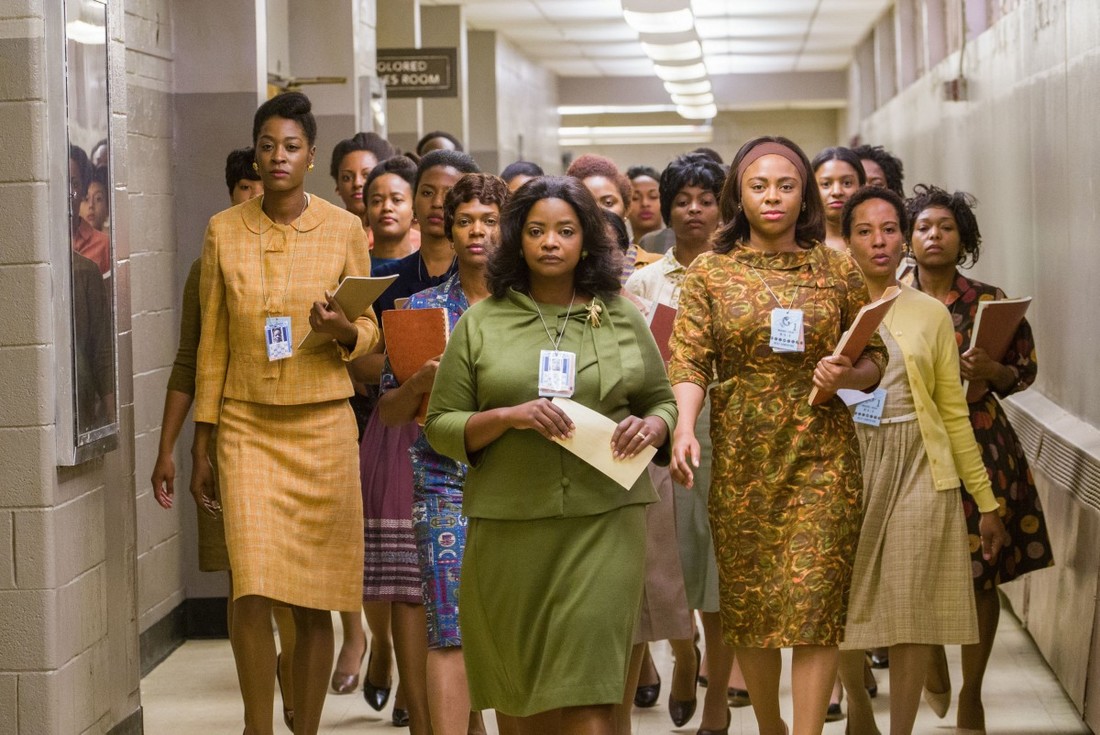One thing that is never expected from films like Hidden Figures is subtlety. Melfi's film conforms to that expectation, as it does indeed have rousing moments of triumph and speeches denouncing injustice, but it also contains more insidious ways that racism and sexism keeps boots on necks. Much is made of the distance that Katherine has to travel to the segregated bathroom, time that takes her away from her desk in the mile-plus round trip, and Harrison notices, making a mental note about what he perceives as long breaks and socking it away for the next time he has the opportunity to hire a black woman. Segregation makes her life more difficult, and it reinforces the prejudices that instituted it in the first place. In handing off reports to her superior Paul Stafford (Jim Parsons), Katherine also is forbidden from putting her name on them, despite her authorship of them. To paraphrase the Hamilton play, these are historical documents about who gets to tell the story of NASA, and the organization is conspiring to only allow a chosen few to be the storytellers.
The NASA setting, so often a successful one in terms of stakes and storytelling, proves to be equally fertile ground for a civil rights story. This is an institution that runs on hard facts and proofs, a place where something as subjective as racism should theoretically have long ago been banished. However, as the Ben Carsons of the world so often illustrate, expertise in one area does not automatically confer expertise or aptitude in another. A great talent for engineering is far away from skills like management or judging the talents of others, but people like Stafford have never learned that lesson. These are rational people with irrational beliefs, willing to jettison the potential of millions of willing participants for something as superficial as skin color. Energy that could better be spent on productive measures is wasted on suspicion, with whites being dismissive towards blacks and men being dismissive towards women, all of which are supposed to have the same goal.
The biggest flaw in the film is that Melfi and Schroeder do rely on white saviors like Harrison and the friendly astronaut John Glenn (Glen Powell) to open doors for its protagonists. A particularly laughable scene finds Harrison completely in the dark about the presence of segregated bathrooms at his facility, which prompts him to take a fire axe to the sign. The film needs him to be an oblivious champion, though bashful cog would have been just as good and not detracted from the story. Glenn also sticks up for Katherine, insisting in his jocular way that she be in the important rooms. Characters like these, and the judge that Mary cajoles into letting her go to school, are shown as gatekeepers who very well could have arbitrarily shut the door. This does somewhat devalue the achievements of the protagonists. There but for the grace of white guys in high places go they. This may well have been the true history, but the film doesn't need to so lionize these characters, as if not being retrograde buffoons is an equal accomplishment to prevailing in the face of systemic racism and sexism.
Hidden Figures already has a great story to work off of, and the actor's playing the heroes further elevate the film. Monae is full of pluck and self-confidence, powering through people on both her knowledge of the material and her knowledge of how charming she is. Spencer is a beacon of strength, a wholly believable leader to the women in her supervision, and a visionary who understands how she can continue to make herself and her team valuable in spite of their race. Henson plays Katherine as frazzled and somewhat mousy, but the righteous rage under the surface is allowed to come out in a show-stopping scene. This is how one knows that Hidden Figures is working. It can make both a big blow-up scene and an engagement scene feel powerful and fresh, and both of those quasi-miracles are on Henson. Together, the trio has an undeniable chemistry, loving and supportive of each other at work and at home.
Every year contains a handful of period civil rights films, a genre that is sadly one of the few leading vehicles for black actors. Hidden Figures fits squarely in that tradition, but the power of the story from a racial and gender perspective makes it more potent than, say, the Jesse Owens biopic that came and went. STEM careers, like the three protagonists wildly succeeded at, continue to be underpopulated by both women and African-Americans, and about as often as a period civil rights film comes out, an old white scientist or college president says something retrograde about that being somehow innate, reinforcing old stereotypes that these women are perfect counterexamples of. While Hidden Figures was in theaters, Spencer famously rented out whole showings and brought entire underserved middle schools on a field trip so they could bask in the accomplishments being justly praised onscreen. STEM is supposed to be a great leveler, where a sturdy bridge is a sturdy bridge no matter who drew up the plans, where the mysteries of the universe are laid bare to anyone willing to do the work. Hidden Figures understands that this is often not true, but if more people knew of these women and so many others like them, it could be. A-

 RSS Feed
RSS Feed